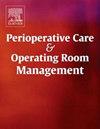乳房手术后恢复质量:一项比较地塞米松和右美托咪定辅助罗哌卡因在超声引导下单次穿刺胸膜中点横突阻滞的随机临床试验
IF 1
Q2 Nursing
Perioperative Care and Operating Room Management
Pub Date : 2024-12-20
DOI:10.1016/j.pcorm.2024.100456
引用次数: 0
摘要
中点胸膜横断阻滞(MTPB)是最近引入的一种阻滞,用于减轻胸外科手术患者的术后疼痛。本研究旨在比较接受改良乳房根治术(MRM)的乳腺癌患者,在0.75%罗哌卡因中加入地塞米松和右美托咪定作为佐剂,单次注射中点横突胸膜阻滞(MTPB)后24小时的恢复质量。设计单中心、评估盲、随机临床试验方法将60例ASA PS 1-2例MRM女性随机分为2组,分别给予地塞米松8mg或右美托咪定1mcg/kg辅助治疗。主要目的是通过术后24小时的恢复质量(QoR-15)问卷来确定恢复质量。次要目的是确定镇痛持续时间、术后休息和运动时疼痛的NRS评分、镇痛药的总累积需要量、患者对阻滞的满意度以及未来再次接受周围神经阻滞的意愿。结果地塞米松组和右美托咪定组的QoR‐15评分分别为128.20±6.93和128.37±4.06。地塞米松组和右美托咪定组镇痛时间分别为10.85±5.31 h和20.20±11.26 h (P <;0.01)。地塞米松组在休息时的所有时间点以及运动时的1、4、8、12小时的疼痛严重程度均显著升高。术中右美托咪定组在5分钟、切口、10分钟、15分钟、20分钟、25分钟和30分钟时收缩压和心率较低。右美托咪定组在5分钟、切口、15分钟和20分钟时舒张压较低(P和lt;0.01)。两组术后血压比较,但右美托咪定组HR较低,同时NRS评分较低(P <;0.01)。右美托咪定组24 h内PCM消耗较低(P <;0.01)。两组患者满意度评分具有可比性。结论术后单次超声引导下,右美托咪定联合地塞米松联合罗哌卡因胸膜中点横切阻滞,患者报告恢复质量良好。本文章由计算机程序翻译,如有差异,请以英文原文为准。
Quality of recovery after breast surgery: A randomized clinical trial comparing dexamethasone with dexmedetomidine as adjuvant to ropivacaine in ultrasound guided single shot mid- point transverse process to pleura block
Background
Mid-point transverse to pleura block (MTPB) is a recently introduced block used to alleviate postoperative pain in patients undergoing thoracic surgeries. The present study aims to compare the quality of recovery at 24 h post-operatively after adding dexamethasone and dexmedetomidine as adjuvants to 0.75 % ropivacaine in a single shot mid-point transverse process to pleura block (MTPB) in patients undergoing modified radical mastectomy (MRM) for carcinoma breast.
Design
Single center, assessor blinded, randomized clinical trial
Methods
Sixty ASA PS 1–2 females posted for MRM were randomized into 2 groups to receive either dexamethasone 8 mg or dexmedetomidine 1mcg/kg as adjuvant to 0.75 % ropivacaine in MTPB. The primary objective was to determine the quality of recovery using the Quality of Recovery (QoR-15) questionnaire at 24 h postoperatively. The secondary objectives were to determine the duration of analgesia, NRS scores for pain at rest and on movement in the post-operative period, total accumulative requirement of analgesics, patient satisfaction with block and future willingness to undergo repeat peripheral nerve block.
Results
The QoR‐15 score was 128.20 ± 6.93 and 128.37 ± 4.06 in the dexamethasone and dexmedetomidine groups respectively. Duration of analgesia was 10.85 ± 5.31 h and 20.20 ± 11.26 h in the dexamethasone and dexmedetomidine groups, respectively (P < 0.01). Pain severity was significantly higher at all timepoints during rest and at 1 h, 4 h, 8 h, and 12 h time points during movement in the dexamethasone group. Intraoperatively, SBP and HR were lower in the dexmedetomidine group at 5 min, at incision, 10 min, 15 min, 20 min, 25 min, and 30 min. DBP was lower in the dexmedetomidine group at 5 min, at incision, 15 min, and 20 min (P < 0.01). Postoperatively BP was comparable among the groups, but HR remained lower in the dexmedetomidine group, coinciding with lower NRS scores at the same time points (P < 0.01). Lower PCM consumption was observed in 24 h in the dexmedetomidine group (P < 0.01). The patient satisfaction score was comparable among the groups.
Conclusions
Preoperative single- shot ultrasound guided mid-point transverse to pleura block with ropivacaine using dexmedetomidine and dexamethasone resulted in a good patient-reported quality of recovery.
求助全文
通过发布文献求助,成功后即可免费获取论文全文。
去求助
来源期刊

Perioperative Care and Operating Room Management
Nursing-Medical and Surgical Nursing
CiteScore
1.30
自引率
0.00%
发文量
52
审稿时长
56 days
期刊介绍:
The objective of this new online journal is to serve as a multidisciplinary, peer-reviewed source of information related to the administrative, economic, operational, safety, and quality aspects of the ambulatory and in-patient operating room and interventional procedural processes. The journal will provide high-quality information and research findings on operational and system-based approaches to ensure safe, coordinated, and high-value periprocedural care. With the current focus on value in health care it is essential that there is a venue for researchers to publish articles on quality improvement process initiatives, process flow modeling, information management, efficient design, cost improvement, use of novel technologies, and management.
 求助内容:
求助内容: 应助结果提醒方式:
应助结果提醒方式:


